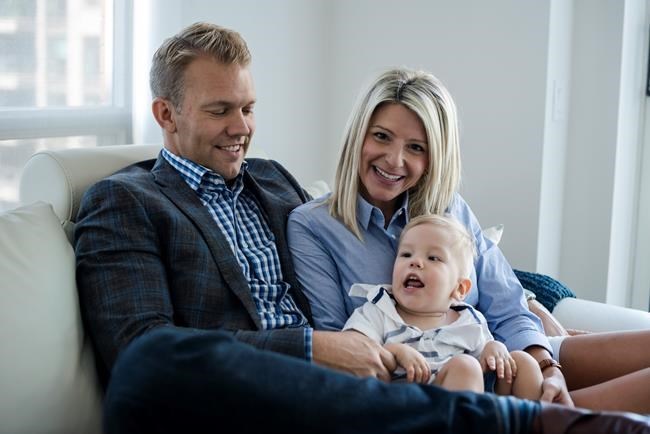
Kim Kucher, her husband Steve and their son Jack, who suffers from in the home of Neuroscientist Dr. Karen Pape in Toronto on Tuesday, August 23, 2016. THE CANADIAN PRESS/Christopher Katsarov
September 21, 2016 - 8:54 AM
TORONTO - Just sitting upright is a battle for two-year-old Jack Pankratz, and so his mother Kim Kucher offers a steady hand and lots of encouragement.
The toddler wobbles even in her arms, as he sways this way and that to look up at the ceiling or yank the corrective glasses off his head.
Jack was diagnosed with cerebral palsy at nine months — the result of a difficult birth in which he suffered oxygen loss to the brain. Doctors predicted permanent cognitive and physical disabilities.
More than a year later, Kucher says he's already defying the odds with the ability to perform a daily regime of barrel rolls, walking drills and core strength exercises.
She credits this in large part to unconventional brain expert and neonatologist Dr. Karen Pape, who gave her something no other medical expert could: hope.
"With some of the medical opinions we were getting it sort of seemed doom-and-gloom for Jack," says Kucher. "And we're parents that aren't just going to settle for that."
She found much-needed support from neuroscientist Pape, a former director of the neonatal followup clinic at Toronto's renowned Hospital for Sick Children, who is challenging traditional notions of baby brain injuries.
"The basic mistake is assuming that there is no recovery," Pape says of the most common childhood motor disability, which afflicted 42,679 Canadians in 2010-2011, according to Statistics Canada.
"I think with all the other improvements, it's going to naturally become a less severe problem."
Pape outlines the theory in her book, "The Boy Who Could Run But Not Walk," in which she argues against the prevailing belief that a cerebral palsy diagnosis inevitably means lifelong, permanent disability with no cure.
Instead, she says the typical limping gait associated with the condition is a bad habit formed by toddlers with an immature brain still recovering from intense trauma. And bad habits can be replaced by good ones, even among teenagers and adults.
The epiphany came after the mother of a former patient announced that her son had just made a competitive soccer team, despite the fact he still limped on the left side with one arm held up. So Pape asked the boy to run.
"And he just took off like a bat out of hell down to the other end of the hallway, running perfectly. And then he did a perfect pivot turn," she says. "And he comes running back and right in front of me he does a perfect pivot turn on his damaged leg. And I said: 'You can't do that!' And it just was such a shock."
It made no sense, until she considered the neuroplasticity in adults who had suffered a stroke and yet went on to a full recovery. If an old, deteriorating brain could regrow new cells and rewire new connections, why couldn't a young, growing brain with a similar injury fully recover?
She concluded that this boy's abnormal walk — something normal to him since he never learned to walk properly to begin with — hid the fact his brain had actually healed. And it was with this healed, more sophisticated brain, that he learned to run perfectly.
In Pape's mind, there's no reason for severe cases of cerebral palsy to persist. She hopes her book can arm parents with information they might need to push therapists and pediatricians to consider their child's full potential.
"Sixty per cent of the kids with CP are (mild to moderate) and walk independently. Why shouldn't they be normal?" she says, noting severity is ranked on a scale of one to five.
"I really believe the ones should be normal, twos should be ones, threes should be two. At least half of the fours can make it all the way up to a two, and a significant number of the fives can do it, too."
Kucher is working hard to give Jack every opportunity to move up from his assessment — somewhere between a three and a four.
Jack meets daily with a variety of experts in physiotherapy, conductive education, speech and language, and vision therapy. It's a demanding regime that sends the stay-at-home Oakville, Ont., mom driving from one appointment to another across the Greater Toronto Area, but she and her husband say it's worth it.
"Dr. Pape sees people with cerebral palsy for who they are and their potential. No glass ceiling. And that was the first time we'd ever heard anything like that from a specialist, a physician of such training," she says, tearing up.
"It was eye-opening for us. And it was that moment where we thought, 'OK, there is some hope here.'"
———
Online: http://www.karenpapemd.com
News from © The Canadian Press, 2016